Opening of Bedding-Parallel Fractures in the Shale Oil Reservoirs of the Paleogene Funing Formation, Subei Basin, China
Abstract
1. Introduction
2. Geological Setting
3. Samples and Methods
3.1. Petrographic Observations
3.2. Fluid Inclusions
3.3. Paleo-Pressure Modeling
3.4. Basin Modeling
3.5. Reflectance Measurement
4. Results
4.1. Bedding-Parallel Fractures Mineralized with Calcite
4.2. Fluid-Inclusion Petrography
4.3. Fluid-Inclusion Microthermometry
4.4. Fluid-Inclusion Paleo-Pressure Modeling
4.5. Burial and Hydrocarbon Generation History
4.6. Reflectance
5. Discussion
5.1. Controversy over Bedding-Parallel Fracture Opening
5.2. Oil Generation-Driven Bedding-Parallel Fracture Opening
6. Conclusions
Author Contributions
Funding
Data Availability Statement
Conflicts of Interest
References
- Meng, Q.; Hao, F.; Tian, J. Origins of non-tectonic fractures in shale. Earth-Sci. Rev. 2021, 222, 103825. [Google Scholar] [CrossRef]
- Meng, Q.; Hooker, J.; Cartwright, J. Early overpressuring in organic-rich shales during burial: Evidence from fibrous calcite veins in the Lower Jurassic Shales-with-Beef Member in the Wessex Basin, UK. J. Geol. Soc. 2017, 174, 869–882. [Google Scholar] [CrossRef]
- Hooker, J.N.; Abu-Mahfouz, I.S.; Meng, Q.; Cartwright, J. Fractures in mudrocks: Advances in constraining timing understanding mechanisms. J. Struct. Geol. 2019, 125, 166–173. [Google Scholar] [CrossRef]
- Gasparrini, M.; Sassi, W.; Gale, J.F.W. Natural sealed fractures in mudrocks: A case study tied to burial history from the Barnett Shale Fort Worth Basin Texas, USA. Mar. Pet. Geol. 2014, 55, 122–141. [Google Scholar] [CrossRef]
- Luan, G.; Dong, C.; Azmy, K.; Lin, C.; Ma, C.; Ren, L.; Zhu, Z. Origin of bedding-parallel fibrous calcite veins in lacustrine black shale: A case study from Dongying Depression, Bohai Bay Basin. Mar. Pet. Geol. 2019, 102, 873–885. [Google Scholar] [CrossRef]
- Lu, H.; Cao, S.; Dong, S.; Lyu, W.; Zeng, L. Control of lamination on bedding-parallel fractures in tight sandstone reservoirs: The seventh member of the upper Triassic Yanchang Formation in the Ordos Basin, China. Front. Earth Sci. 2024, 12, 1428316. [Google Scholar] [CrossRef]
- Ma, C.; Dong, C.; Elsworth, D.; Wang, Q.; Huang, Z.; Liu, H.; He, Y. Insights from electron backscatter diffraction into the origin of fibrous calcite veins in organic-rich shale from lower Es3 to upper Es4, Jiyang Depression, China. Mar. Pet. Geol. 2020, 113, 104131. [Google Scholar] [CrossRef]
- Zhang, J.; Jiang, Z.; Jiang, X.; Wang, S.; Liang, C.; Wu, M. Oil generation induces sparry calcite formation in lacustrine mudrock, Eocene of east China. Mar. Pet. Geol. 2016, 71, 344–359. [Google Scholar] [CrossRef]
- Su, A.; Bons, P.D.; Chen, H.; Feng, Y.X.; Zhao, J.X.; Song, J. Age, material source, and formation mechanism of bedding-parallel calcite beef veins: Case from the mature Eocene lacustrine shales in the Biyang Sag, Nanxiang Basin, China. GSA Bull. 2022, 134, 1811–1833. [Google Scholar] [CrossRef]
- Cobbold, P.R.; Zanella, A.; Rodrigues, N.; Løseth, H. Bedding-parallel fibrous veins (beef and cone-in-cone): Worldwide occurrence and possible significance in terms of fluid overpressure, hydrocarbon generation and mineralization. Mar. Pet. Geol. 2013, 43, 1–20. [Google Scholar] [CrossRef]
- Zhang, J.; Jiang, Z.; Wang, S.; Wang, R.; Zhang, Y.; Du, W. Bedding-parallel calcite veins as a proxy for shale reservoir quality. Mar. Pet. Geol. 2021, 127, 104975. [Google Scholar] [CrossRef]
- Sun, B.; Liu, X.P.; Liu, J.; Liu, Q.D.; Duan, H.L.; Liu, S.L.; Gao, X.; Xing, Y.J. Lacustrine shale oiliness influenced by diabase intrusions in the Paleogene Funing Formation, Subei Basin, China. Pet. Sci. 2023, 20, 2683–2694. [Google Scholar] [CrossRef]
- Zhang, P.; Yin, Y.; Lu, S.; Wang, J.; Zhang, J.; Zhi, Q.; Huang, H. Key factors controlling oil contents in different lithofacies shales from the Funing Formation, Subei Basin: Evidence from scanning electron microscopy. Geoenergy Sci. Eng. 2023, 229, 212115. [Google Scholar] [CrossRef]
- Fan, X.; Lu, Y.; Liu, Z.; Lu, Y.; Zhang, J.; Deng, K.; Zhou, T.; Tai, H.; Li, L. Lacustrine shale lithofacies and depositional environment in the paleocene second member of the funing formation, subei basin, China: Insights into shale oil development prospects. Mar. Pet. Geol. 2024, 164, 106849. [Google Scholar] [CrossRef]
- Su, A.; Chen, H.; Feng, Y.X.; Zhao, J.X.; Liu, Q. Igneous intrusion drives in-reservoir oil thermal cracking: A case from the Subei Basin, eastern China. AAPG Bull. 2024, 108, 2045–2072. [Google Scholar] [CrossRef]
- Liu, Y.; Chen, Q.H.; Hu, K.; Wang, X.; Gao, F. Comparison of the Bohai Bay Basin and Subei-South Yellow Sea Basin in the structural characteristics and forming mechanism. Geotecton. Metallog. 2014, 38, 38–51, (In Chinese with English Abstract). [Google Scholar]
- Chen, A.D. Tectonic features of the Subei Basin and the forming mechanism of its dustpan-shaped fault depression. Oil Gas Geol. 2010, 31, 140–150, (In Chinese with English Abstract). [Google Scholar]
- Liu, Y.; Chen, Q.; Wang, X.; Hu, K.; Cao, S.; Wu, L.; Gao, F. Influence of normal fault growth and linkage on the evolution of a rift basin: A case from the Gaoyou depression of the Subei Basin, eastern China. AAPG Bull. 2017, 101, 265–288. [Google Scholar] [CrossRef]
- Zan, L.; Luo, W.F.; Yin, Y.L.; Jing, X.M. Formation conditions of shale oil and favorable targets in the second member of Paleogene funing Formation in Qintong sag, Subei Basin. Pet. Geol. Exp. 2021, 43, 233–241. [Google Scholar]
- Liu, X.; Jin, Z.; Lai, J.; Fan, X.; Guan, M.; Shu, H.; Wang, G.; Liu, M.; Luo, Y. Fractal behaviors of NMR saturated and centrifugal T2 spectra in oil shale reservoirs: The Paleogene Funing formation in Subei basin, China. Mar. Pet. Geol. 2021, 129, 105069. [Google Scholar] [CrossRef]
- Guan, M.; Liu, X.; Jin, Z.; Lai, J.; Liu, J.; Sun, B.; Liu, T.; Hua, Z.; Xu, W.; Shu, H.; et al. Quantitative characterization of various oil contents and spatial distribution in lacustrine shales: Insight from petroleum compositional characteristics derived from programed pyrolysis. Mar. Pet. Geol. 2022, 138, 105522. [Google Scholar] [CrossRef]
- Lee, T.Y.; Lawver, L.A. Cenozoic plate reconstruction of Southeast Asia. Tectonophysics 1995, 251, 85–138. [Google Scholar] [CrossRef]
- Qiu, X.; Chen, W.; Li, H.; Duan, H. Strike-slip structures and hydrocarbon accumulation in complex fault blocks in Subei Basin. Pet. Geol. Exp. 2023, 45, 393–401, (In Chinese with English Abstract). [Google Scholar]
- Rui, X.; Zhou, Y.; Li, Z.; Zhang, Q. Characteristics of source rocks and reservoirs of the Funing Formation in the Subei Basin and their bearing on future shale oil exploration. Mar. Geol. Quat. Geol. 2020, 40, 133–145, (In Chinese with English Abstract). [Google Scholar]
- Yao, H.S.; Zan, L.; Gao, Y.Q.; Hua, C.X.; Yu, W.R.; Luo, W.F.; Ma, X.D. Main controlling factors for the enrichment of shale oil and significant discovery in second member of Paleogene Funing Formation, Qintong Sag, Subei Basin. Pet. Geol. Exp. 2021, 43, 776–783. [Google Scholar]
- Yun, L.; He, X.P.; Hua, C.X.; Zan, L. Accumulation characteristics and resource potential of Paleogene continental shale oil in Qintong sag of Subei Basin. Acta Pet. Sin. 2023, 44, 176–187. [Google Scholar]
- Bourdet, J.; Pironon, J.; Levresse, G.; Tritlla, J. Petroleum accumulation and leakage in a deeply buried carbonate reservoir, 558 Níspero field (Mexico). Mar. Pet. Geol. 2010, 27, 126–142. [Google Scholar] [CrossRef]
- Su, A.; Chen, H.; Feng, Y.X.; Zhao, J.X. LA-ICP-MS U-Pb dating and geochemical characterization of oil inclusion-bearing calcite cements: Constraints on primary oil migration in lacustrine mudstone source rocks. GSA Bull. 2022, 134, 2022–2036. [Google Scholar] [CrossRef]
- Li, C.; Qian, S.; Zheng, Y. Paleopressure during Hydrocarbon Charging and Its Evolution in the Funing Formation of the Gaoyou Sag, Subei Basin, Eastern China. Minerals 2024, 14, 821. [Google Scholar] [CrossRef]
- Su, A.; Chen, H.; Lei, M.; Li, Q.; Wang, C. Paleo-pressure evolution and its origin in the Xihu slope belt of the Xihu Depression, East China Sea Basin. Mar. Pet. Geol. 2019, 107, 198–213. [Google Scholar] [CrossRef]
- Zhang, P.; Zhou, Z.; Xu, C. Thermo-tectonic history of the Lower Yangtze area since Late Cretaceous: Evidence from apatite fission track analysis of sandstones from Pukou Formation. Offshore Oil 2009, 29, 574–579, (In Chinese with English Abstract). [Google Scholar]
- Liu, X.P.; Yang, L.G.; Xu, J. Restoration of Eocene Erosion thickness in Gaoyou sag. Xinjiang Pet. Geol. 2004, 25, 128–130. [Google Scholar]
- Sweeney, J.J.; Burnham, A.K. Evaluation of a simple model of vitrinite reflectance based on chemical kinetics. AAPG Bull. 1990, 74, 1559–1570. [Google Scholar] [CrossRef]
- Burnham, A.K.; Sweeney, J.J. A chemical kinetic model of vitrinite maturation and reflectance. Geochim. Cosmochim. Acta 1989, 53, 2649–2657. [Google Scholar] [CrossRef]
- Liu, B.; Schieber, J.; Mastalerz, M. Petrographic and micro-FTIR study of organic matter in the Upper Devonian New Albany Shale during thermal maturation: Implications for kerogen transformation. In Mudstone Diagenesis: Research Perspectives for Shale Hydrocarbon Reservoirs, Seals, and Source Rocks; AAPG Memoir: Tulsa, OK, USA, 2019; pp. 165–188. [Google Scholar]
- Bons, P.D.; Montenari, M. The formation of antitaxial calcite veins with well-developed fibres, Oppaminda Creek, South Australia. J. Struct. Geol. 2005, 27, 231–248. [Google Scholar] [CrossRef]
- Bons, P.D.; Jessell, M.W. Experimental simulation of the formation of fibrous veins by localised dissolution-precipitation creep. Mineral. Mag. 1997, 61, 53–63. [Google Scholar] [CrossRef]
- Blamey, N.J.; Ryder, A.G. Hydrocarbon fluid inclusion fluorescence: A review. In Reviews in Fluorescence 2007; Springer: New York, NY, USA; pp. 299–334.
- George, S.C.; Ruble, T.E.; Dutkiewicz, A.; Eadington, P.J. Assessing the maturity of oil trapped in fluid inclusions using mo- lecular geochemistry data and visually-determined fluorescence colours. Appl. Geochem. 2001, 16, 451–473. [Google Scholar] [CrossRef]
- Bao, H.Y.; Guo, Z.F.; Huang, Y.P.; Zhang, L.L. Tectonic-Thermal Evolution of the Subei Basin since the Late Cretaceous. Geol. J. China Univ. 2013, 19, 574–579. [Google Scholar]
- Curiale, J.A. Origin of solid bitumens, with emphasis on biological marker results. Org. Geochem. 1986, 10, 559–580. [Google Scholar] [CrossRef]
- Cobbold, P.R.; Rodrigues, N. Seepage forces, important factors in the formation of horizontal hydraulic fractures and bedding-parallel fibrous veins (‘beef’ and ‘cone-in-cone’). Geofluids 2007, 7, 313–322. [Google Scholar] [CrossRef]
- Ukar, E.; Lopez, R.G.; Gale, J.F.; Laubach, S.E.; Manceda, R. New type of kinematic indicator in bed-parallel veins, Late Jurassic–Early Cretaceous Vaca Muerta Formation, Argentina: EW shortening during Late Cretaceous vein opening. J. Struct. Geol. 2017, 104, 31–47. [Google Scholar] [CrossRef]
- Hart, B.S.; Schieber, J.; Kalinec, J. Clay diagenesis and overpressure development in Upper Cretaceous and Tertiary shales of South Texas. Mar. Pet. Geol. 2023, 147, 105978. [Google Scholar] [CrossRef]
- Rodrigues, N.; Cobbold, P.R.; Loseth, H.; Ruffet, G. Widespread bedding-parallel veins of fibrous calcite (‘beef’) in a mature 587 source rock (Vaca Muerta Fm, Neuquén Basin, Argentina): Evidence for overpressure and horizontal compression. J. Geol. Soc. 2009, 166, 695–709. [Google Scholar] [CrossRef]
- Weger, R.J.; Murray, S.T.; McNeill, D.F.; Swart, P.K.; Eberli, G.P.; Blanco, L.R.; Rueda, L.E. Paleothermometry and distribution of calcite beef in the Vaca Muerta Formation, Neuquén Basin, Argentina. AAPG Bull. 2019, 103, 931–950. [Google Scholar] [CrossRef]
- Zanella, A.; Cobbold, P.R.; de Veslud, C.L.C. Physical modelling of chemical compaction, overpressure development, hydraulic fracturing and thrust detachments in organic-rich source rock. Mar. Pet. Geol. 2014, 55, 262–274. [Google Scholar] [CrossRef]
- Meng, Q.; Hooker, J.; Cartwright, J. Genesis of natural hydraulic fractures as an indicator of basin inversion. J. Struct. Geol. 2017, 102, 1–20. [Google Scholar] [CrossRef]
- Spencer, C.W. Hydrocarbon generation as a mechanism for overpressuring in Rocky Mountain region. AAPG Bull. 1987, 71, 368–388. [Google Scholar] [CrossRef]
- Su, A.; Chen, H.; Feng, Y.X.; Zhao, J.X.; Nguyen, A.D. Multistage fracturing history in the Paleocene lacustrine shale oil reservoirs of the Subei Basin, Eastern China. Mar. Pet. Geol. 2022, 144, 105835. [Google Scholar] [CrossRef]

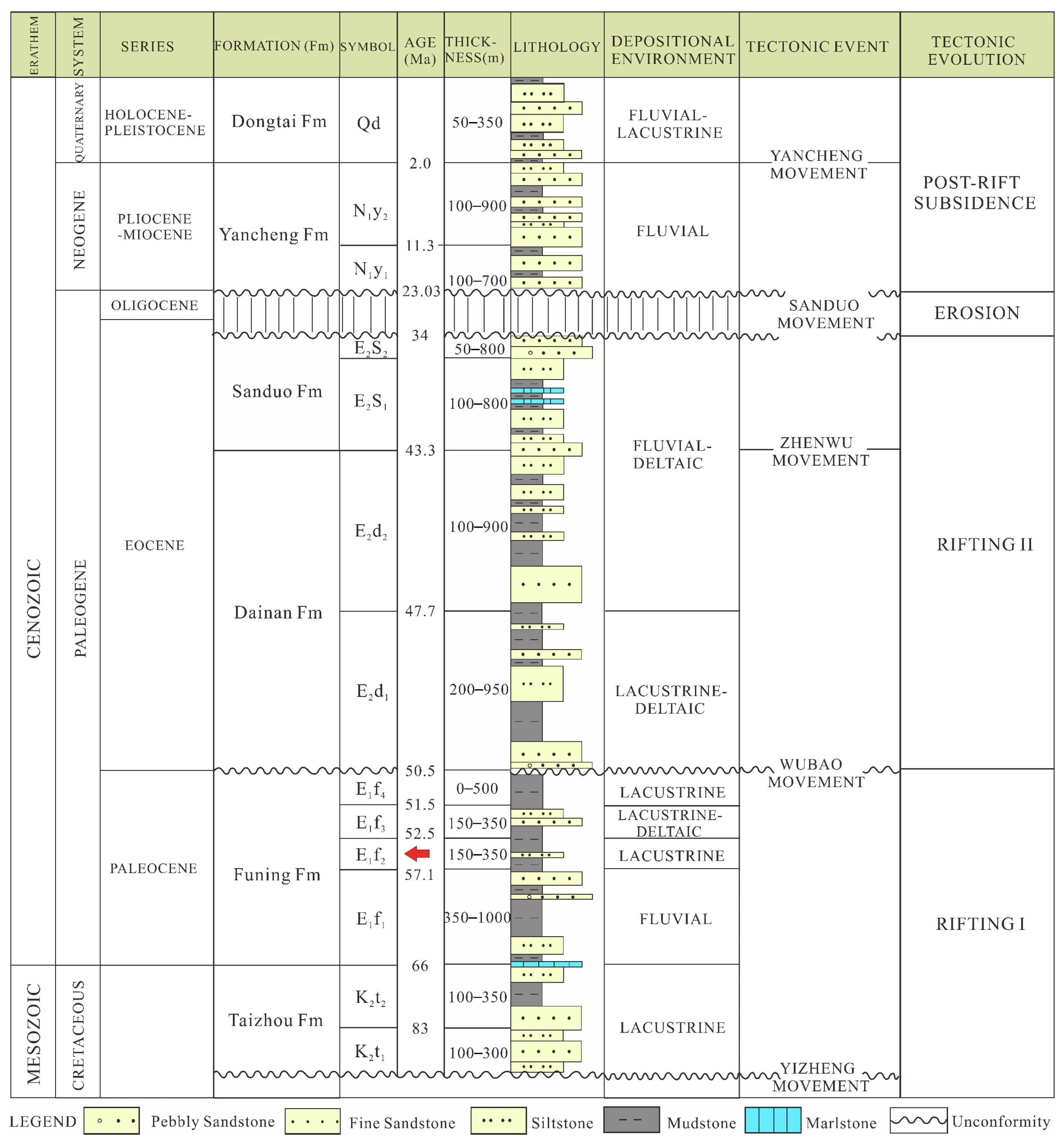
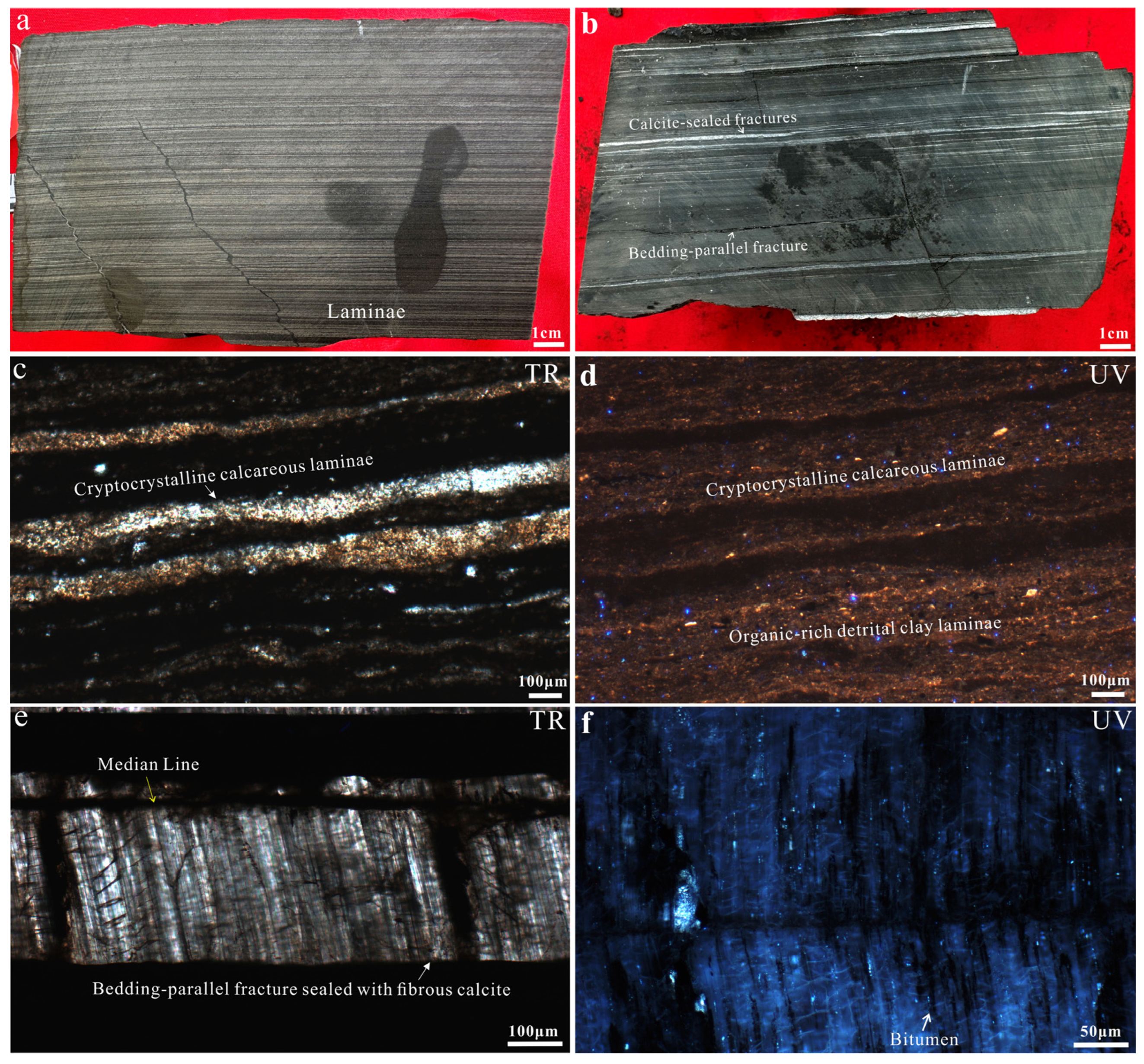
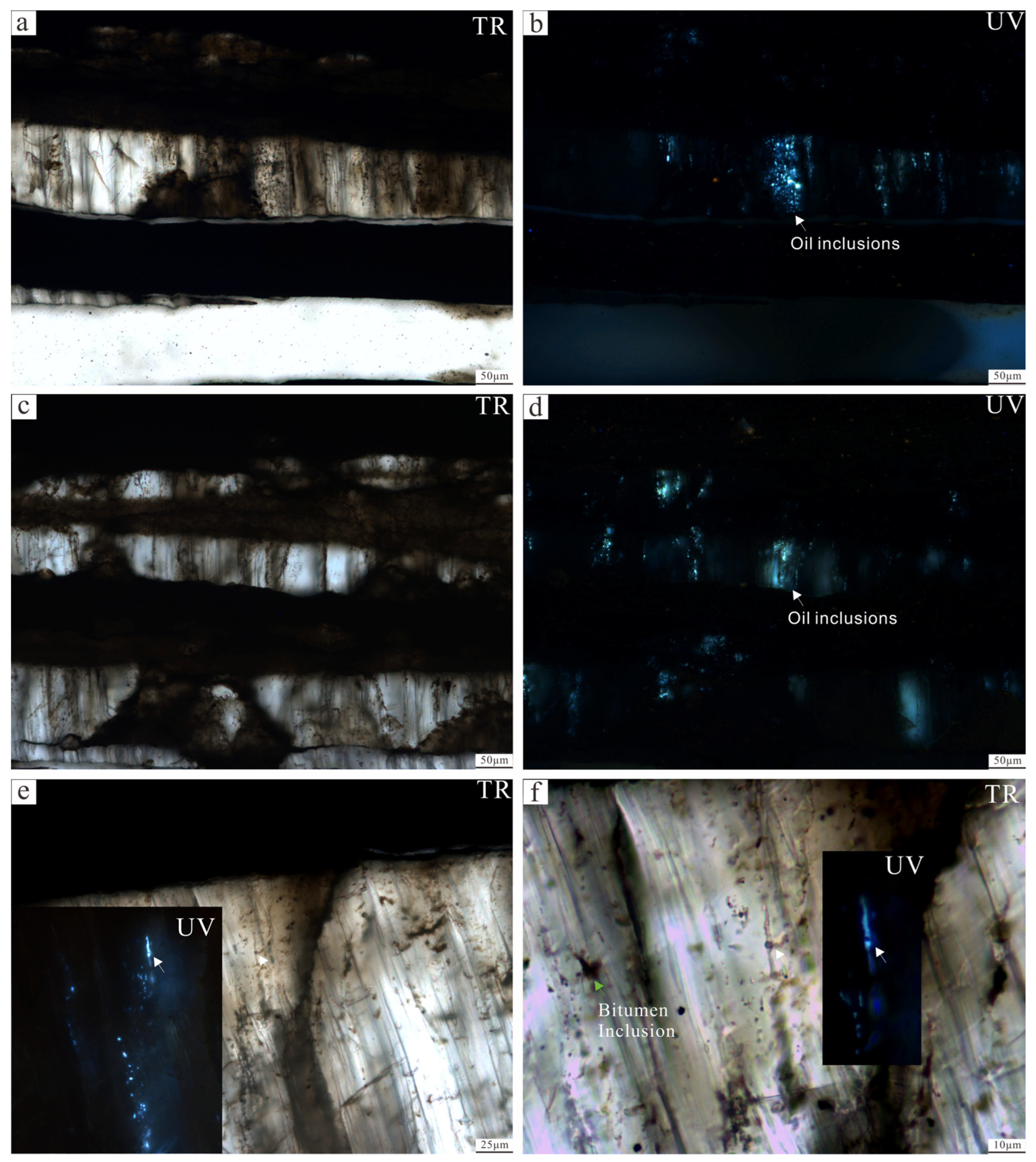
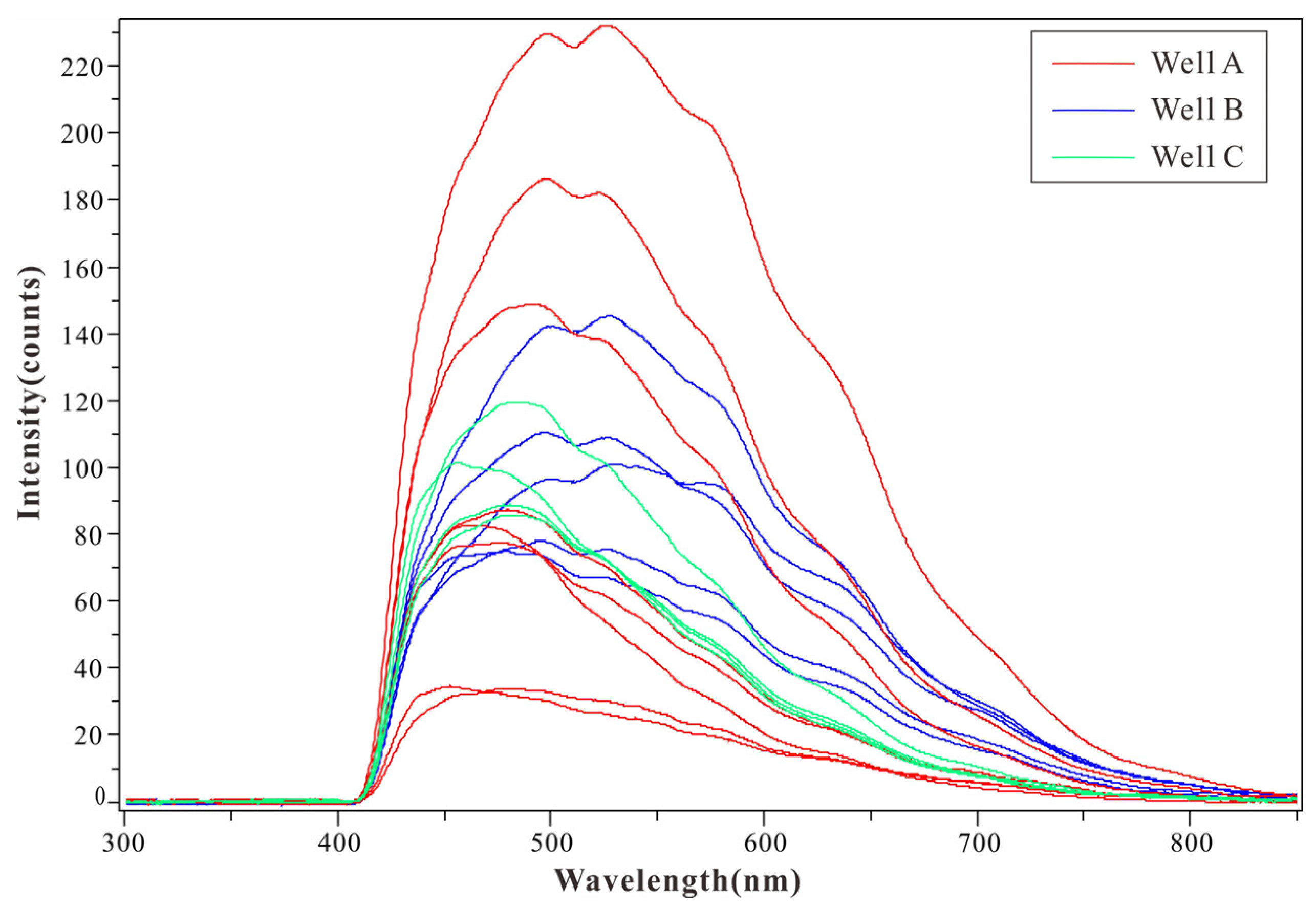
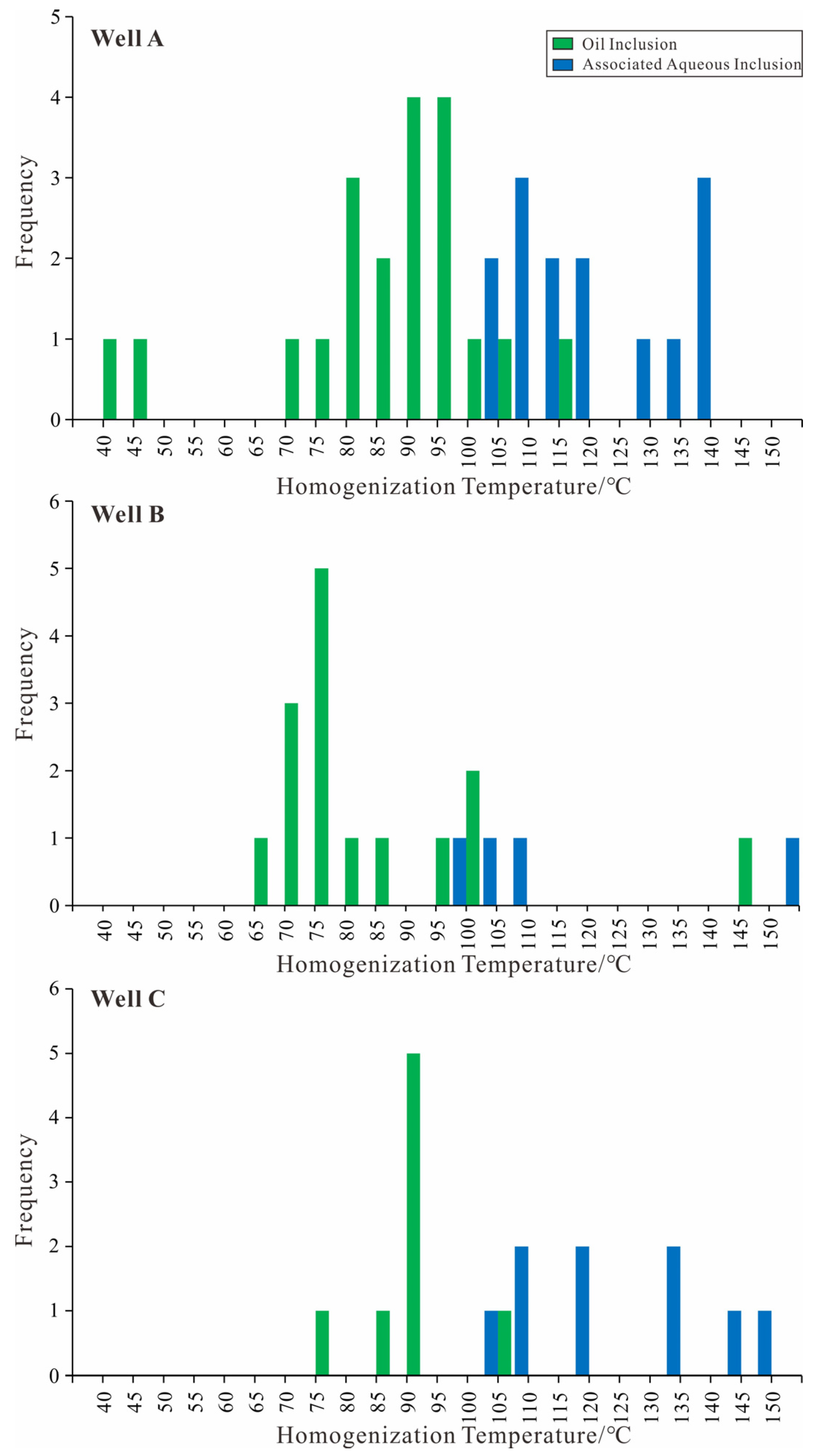
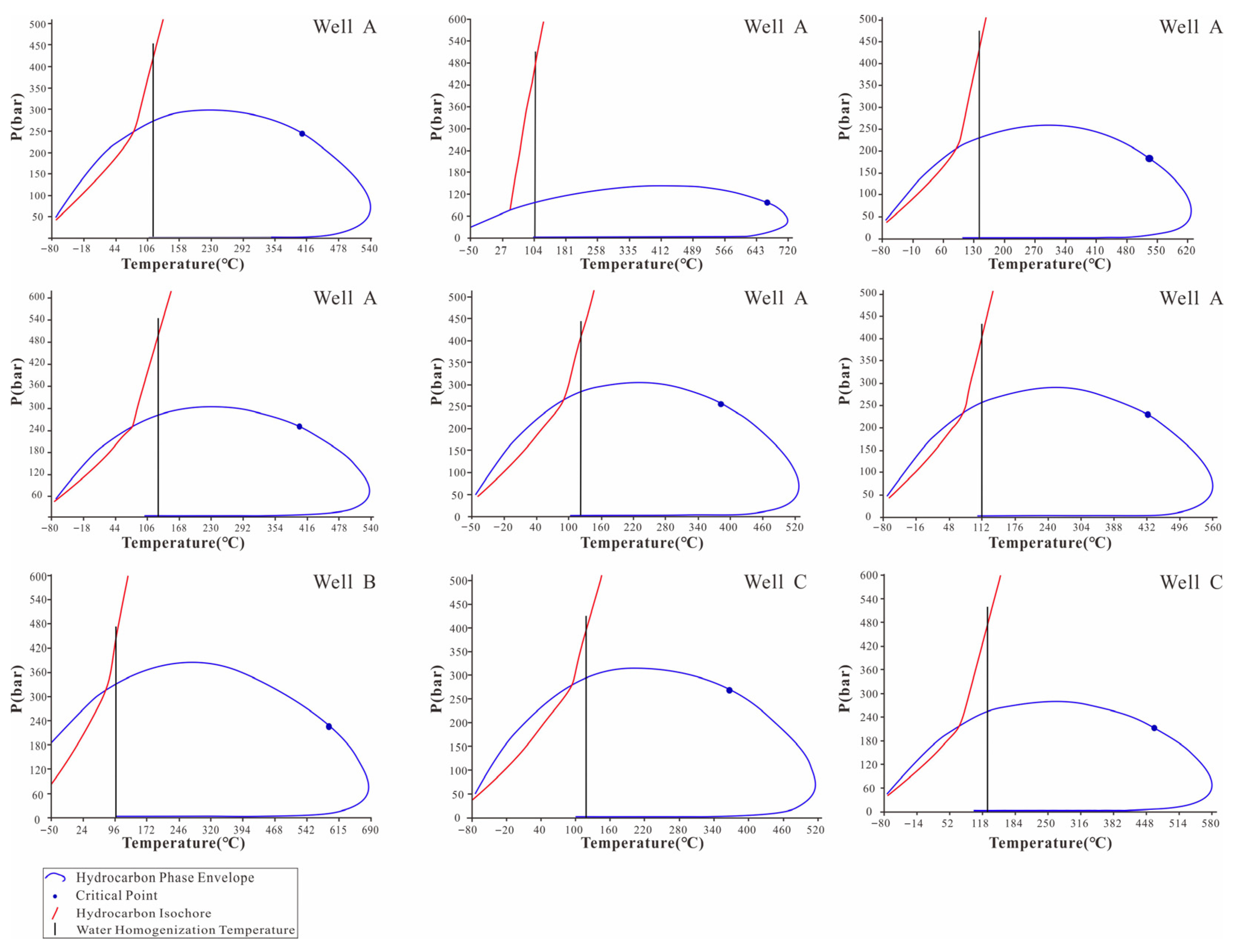

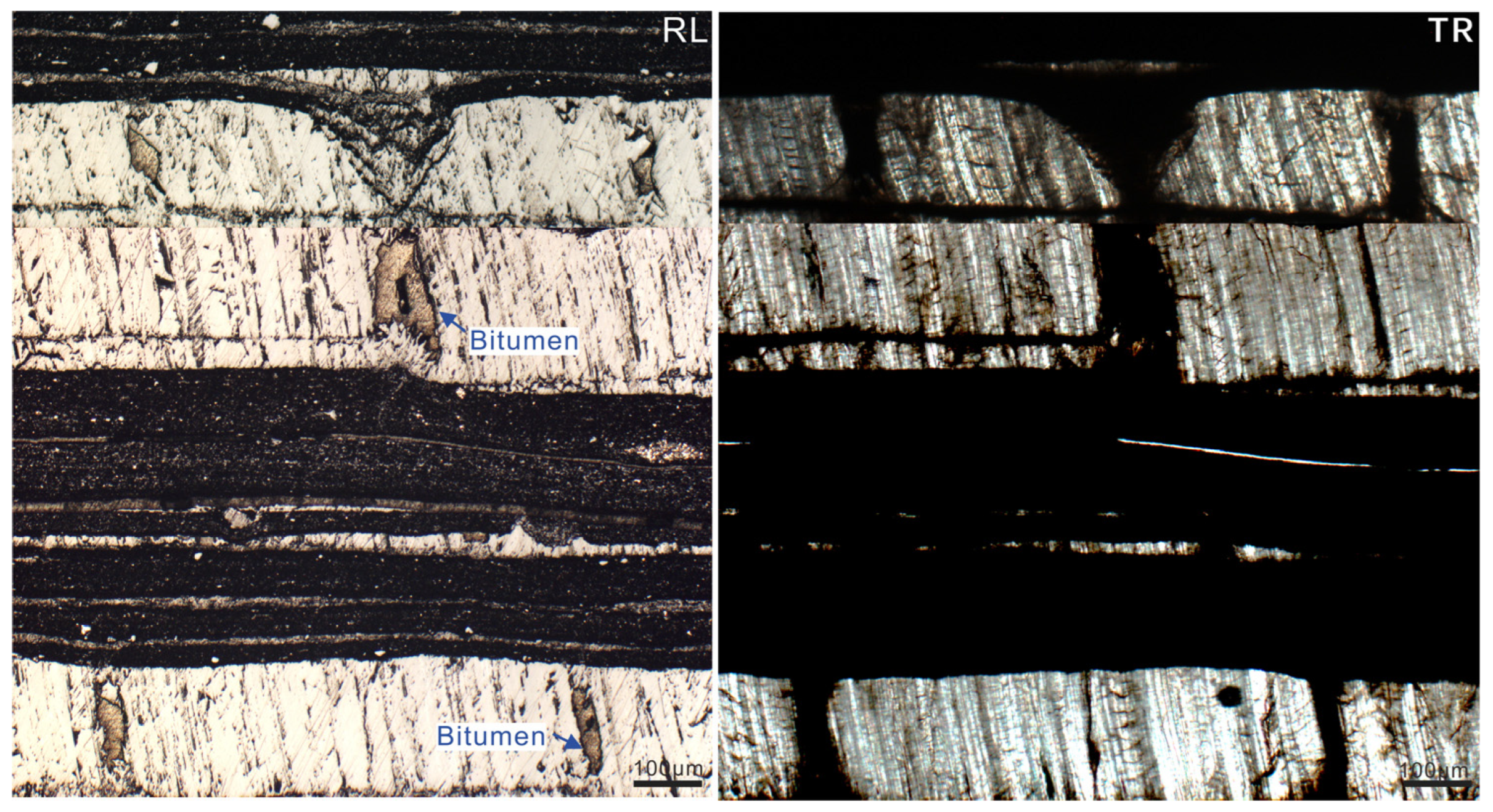
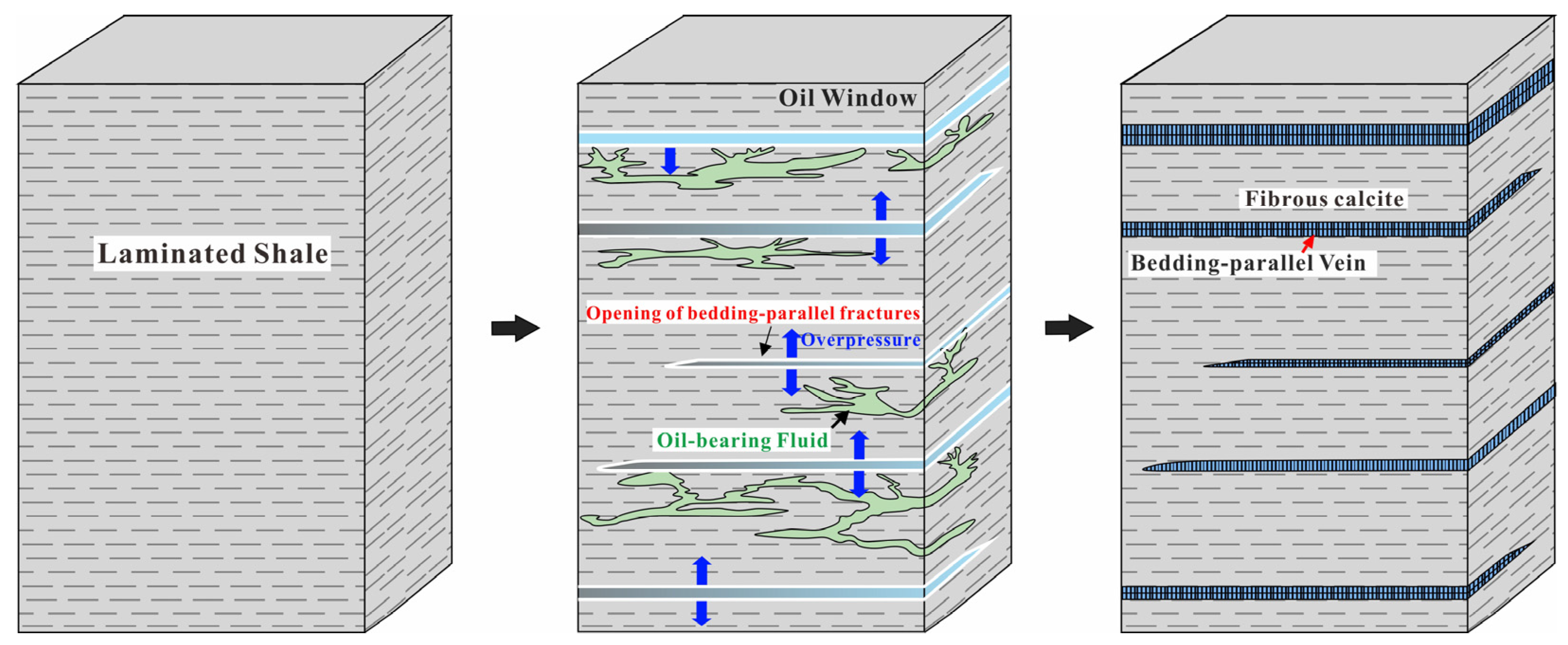
| Well | Thoil/°C | Gas–Liquid Ratio/% | Thaq/°C | Paleo-Pressure/MPa | Paleo Pressure Coefficient |
|---|---|---|---|---|---|
| Well A | 43.2 | 1.3 | 104.4 | 46.6 | 2.27 |
| 88.7 | 12.6 | 119.6 | 39.4 | 1.58 | |
| 81.8 | 10.4 | 115.6 | 40.5 | 1.71 | |
| 93 | 7.8 | 139.4 | 43 | 1.35 | |
| 74.5 | 8.4 | 109.5 | 40.3 | 1.83 | |
| 75.2 | 9.6 | 126 | 48.4 | 1.79 | |
| Well B | 78.8 | 9.2 | 99.6 | 43.6 | 2.36 |
| Well C | 91.8 | 14.1 | 116.5 | 37.9 | 1.59 |
| 75.2 | 7.6 | 126 | 47.6 | 1.74 |
| Depth/m | Type | Number of Point | Standard Deviation | Reflectance/% | Equivalent Vitrinite Reflectance/% |
|---|---|---|---|---|---|
| 4094–4250 | Bitumen | 56 | 0.07 | 0.83 | 0.90 |
| 52 | 0.08 | 0.92 | 0.95 | ||
| 53 | 0.06 | 1.1 | 1.06 | ||
| 64 | 0.07 | 1.15 | 1.09 | ||
| 55 | 0.1 | 1.27 | 1.16 | ||
| Shale | 59 | 0.05 | 0.85 | / | |
| 54 | 0.08 | 0.94 | / | ||
| 63 | 0.06 | 0.97 | / | ||
| 58 | 0.05 | 1.04 | / |
Disclaimer/Publisher’s Note: The statements, opinions and data contained in all publications are solely those of the individual author(s) and contributor(s) and not of MDPI and/or the editor(s). MDPI and/or the editor(s) disclaim responsibility for any injury to people or property resulting from any ideas, methods, instructions or products referred to in the content. |
© 2025 by the authors. Licensee MDPI, Basel, Switzerland. This article is an open access article distributed under the terms and conditions of the Creative Commons Attribution (CC BY) license (https://creativecommons.org/licenses/by/4.0/).
Share and Cite
Wang, Z.; Su, A.; Xia, D.; Lyu, X.; Wu, X. Opening of Bedding-Parallel Fractures in the Shale Oil Reservoirs of the Paleogene Funing Formation, Subei Basin, China. Energies 2025, 18, 5698. https://doi.org/10.3390/en18215698
Wang Z, Su A, Xia D, Lyu X, Wu X. Opening of Bedding-Parallel Fractures in the Shale Oil Reservoirs of the Paleogene Funing Formation, Subei Basin, China. Energies. 2025; 18(21):5698. https://doi.org/10.3390/en18215698
Chicago/Turabian StyleWang, Zhelin, Ao Su, Dongling Xia, Xinrui Lyu, and Xingwei Wu. 2025. "Opening of Bedding-Parallel Fractures in the Shale Oil Reservoirs of the Paleogene Funing Formation, Subei Basin, China" Energies 18, no. 21: 5698. https://doi.org/10.3390/en18215698
APA StyleWang, Z., Su, A., Xia, D., Lyu, X., & Wu, X. (2025). Opening of Bedding-Parallel Fractures in the Shale Oil Reservoirs of the Paleogene Funing Formation, Subei Basin, China. Energies, 18(21), 5698. https://doi.org/10.3390/en18215698






